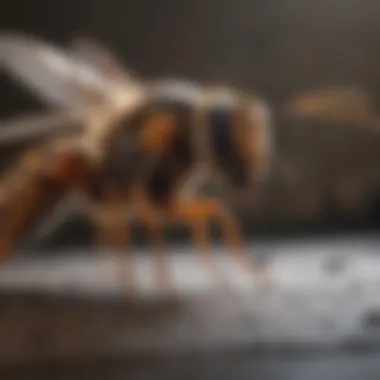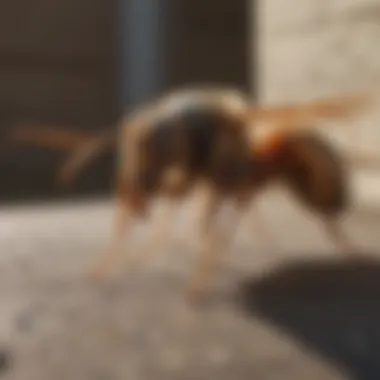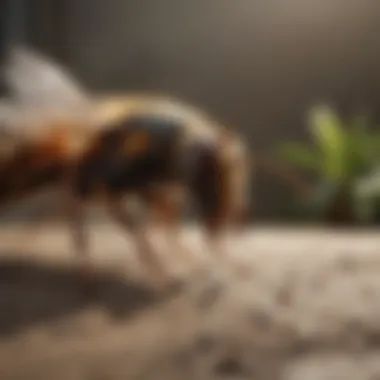Expert Tips for Safely Removing a Hornet from Your Home


Preventive Pest Control Strategies
In the realm of pest control, a proactive approach is key to ensuring a pest-free environment within your home. Implementing robust preventive strategies can significantly reduce the chances of a hornet invasion. One crucial aspect of preventive pest control is safeguarding your house exterior. By meticulously sealing cracks and gaps using high-quality sealants and materials, you create a formidable barrier against unwanted intruders like hornets. Simultaneously, clearing debris such as fallen leaves, branches, and clutter around your property eliminates potential hiding spots for pests, including hornets. To further fortify your defense, adopt effective techniques to prevent pests from entering your home, such as installing mesh screens on windows and doors, which act as a physical deterrent against hornets.
When it comes to yard maintenance, nurturing a pest-free environment begins with essential care routines. Regularly mowing the lawn, trimming overgrown shrubs, and eliminating standing water are fundamental steps in pest prevention. These actions not only enhance the aesthetics of your yard but also discourage hornets and other pests from establishing nests. Furthermore, maintaining indoor cleanliness is imperative for a pest-resistant abode. Expert cleaning tips and techniques, like deep cleaning nooks and crannies, properly storing food items, and promptly fixing leaky plumbing, help eliminate potential attractants for hornets. By upholding these practices, you create an environment that is inhospitable to pests, reducing the likelihood of hornet infestations.
The proper disposal of garbage plays a pivotal role in pest control, especially concerning hornets. Employing efficient waste disposal methods, such as using tightly sealed bins and regularly emptying them, is essential to deter these stinging insects. Proper garbage disposal not only prevents odors that can lure hornets but also minimizes their access to potential food sources. Additionally, exploring innovative ways to safeguard your home against pests, such as incorporating natural deterrents like mint plants or utilizing ultrasonic devices, can provide additional layers of protection.
Identifying Pest Risk Areas
To effectively combat hornets and other pests, a thorough understanding of potential risk areas within your home is imperative. Conducting inspections in moisture-prone areas is a critical step in identifying conditions conducive to pest infestations. By recognizing damp conditions and promptly addressing sources of moisture, such as leaky pipes or faulty drainage systems, you can mitigate the allure of these areas to pests like hornets. Moreover, inspecting crackcont.
Understanding Hornets
Hornet Behavior
Nesting Habits
Nesting habits are a fundamental aspect of hornet behavior. Hornets typically build their nests in secluded areas such as tree branches or eaves of buildings. Understanding these nesting habits is vital as it helps homeowners locate and address potential infestations proactively. By recognizing the key characteristic of nesting habits, individuals can identify early signs of hornet presence and take timely action to prevent further nesting. While nesting habits provide hornets with protection and shelter, they can pose a threat to households, making it essential to address them promptly in the context of this article.
Foraging Patterns
Foraging patterns represent another critical component of hornet behavior. Hornets are known for their systematic approach to foraging, often preying on other insects for sustenance. By examining these foraging patterns, individuals can track hornet activity and predict potential swarm locations. The unique feature of foraging patterns lies in their efficiency, enabling hornets to locate food sources swiftly. However, such patterns may lead hornets to residential areas, heightening the risk of encounters with humans. Therefore, understanding foraging patterns is essential for implementing effective hornet removal techniques discussed in this article.
Response to Threats


How hornets respond to threats is a key factor in hornet behavior. When provoked, hornets exhibit defensive behavior, often stinging perceived aggressors. Recognizing this response is crucial for minimizing risks during hornet removal procedures. By understanding the characteristics of hornets' response to threats, individuals can undertake precautionary measures to reduce confrontations and ensure safe elimination processes. While this defense mechanism is effective for hornets' survival in the wild, it necessitates careful handling and professional intervention when dealing with hornet intrusions in residential settings.
Identifying a Hornet
When facing a potential hornet infestation, identifying these creatures accurately is paramount. By recognizing the physical characteristics that distinguish hornets from bees and wasps, individuals can tailor their hornet removal strategies effectively. Understanding the key features that differentiate hornets helps homeowners make informed decisions regarding pest control measures, ensuring targeted and efficient solutions to hornet invasions.
Physical Characteristics
Hornets possess distinct physical characteristics that set them apart from other stinging insects. From their size and coloration to unique morphological traits, physical distinctions play a vital role in identifying hornets accurately. Recognizing these key characteristics enables individuals to differentiate hornets from bees and wasps, facilitating precise identification during pest management activities. While these physical traits contribute to hornets' ecological roles, they also serve as markers for effective hornet removal, guiding homeowners in the implementation of tailored eradication methods in alignment with the focus of this article.
Differentiating from Bees and Wasps
Distinguishing hornets from bees and wasps is a nuanced process that requires attention to detail. By understanding the specific attributes that separate hornets from similar insects, individuals can avoid misidentifications that may impact the efficacy of hornet removal efforts. Highlighting these distinctive features underscores the importance of accurate identification in formulating targeted and sustainable solutions to hornet presence. Although hornets share certain characteristics with bees and wasps, subtle differences in behavior and appearance can aid in their differentiation, enhancing the precision and success of hornet removal endeavors emphasized in this article.
Precautionary Measures
Precautionary measures are a crucial aspect to consider when dealing with hornets in your house. Understanding the significance of these measures can make a significant difference in ensuring your safety and effectively removing the hornet without excessive risks. By focusing on specific elements such as protective gear and strategies to avoid provocation, you can create a secure environment for both yourself and the hornet. These measures play a key role in minimizing potential harm and handling the situation with confidence.
Protective Gear
When it comes to protective gear, clothing and safety equipment are essential components to safeguard yourself from hornet stings or attacks.
Clothing
Choosing the right clothing is vital in hornet removal. Opt for long-sleeved shirts, thick pants, and closed-toe shoes to protect your body from possible stings. The key characteristic of suitable clothing lies in its ability to provide full coverage and prevent direct exposure to hornets. Additionally, wearing light-colored clothing can help deflect hornets as they are naturally attracted to darker colors. While the unique feature of protective clothing is its ability to offer a physical barrier against stings, its disadvantage may include potential discomfort or heat during warmer weather. However, the benefits of wearing appropriate clothing outweigh the disadvantages by significantly reducing the risk of hornet encounters.
Safety Equipment


Safety equipment, such as face masks, gloves, and goggles, are essential for ensuring added protection during hornet removal procedures. The key characteristic of safety equipment lies in its ability to shield sensitive areas of the body, such as the face and hands, from potential stings or harm. These items are a popular choice for hornet removal due to their ability to enhance safety measures and reduce the likelihood of injuries. The unique feature of safety equipment is its specialized design tailored to provide maximum protection while executing hornet removal tasks. While safety equipment offers various advantages in minimizing risks, potential disadvantages may include limited mobility or comfort when wearing such gear. Despite this, the protective benefits outweigh any inconveniences, making safety equipment a crucial component in your hornet removal toolkit.
Avoiding Provocation
Avoiding provocation is a key strategy in ensuring a smooth hornet removal process by minimizing the chances of agitating the insects and provoking an aggressive response.
Noise Reduction
Noise reduction plays a vital role in maintaining a calm environment during hornet removal. By minimizing loud noises or disruptions, you can prevent alarming the hornets and avoid triggering defensive behaviors. The key characteristic of noise reduction lies in its ability to create a tranquil atmosphere that discourages hornets from feeling threatened. This approach is particularly beneficial in maintaining a harmonious environment conducive to safe hornet removal practices. While the unique feature of noise reduction is its ability to promote a peaceful ambience, a potential disadvantage could be the need to operate in silence, which may limit certain activities. However, the advantages of noise reduction in preventing hornet aggression far outweigh any inconveniences, making it an essential strategy to adopt.
Restricting Movement
Restricting movement is another effective tactic to avoid provoking hornets during removal procedures. By moving calmly and purposefully while minimizing sudden gestures, you can mitigate the risk of triggering defensive responses from the insects. The key characteristic of movement restriction lies in its role in maintaining a non-threatening demeanor, which is essential for preventing hornets from perceiving you as a threat. This strategy is a popular choice for hornet removal as it helps create a sense of security and reduces the likelihood of provoking aggressive behavior. The unique feature of movement restriction is its ability to convey a message of non-aggression, signaling to the hornets that you pose no harm. While a possible disadvantage may include restricted flexibility during movements, the overall benefits of restricting movement for effective hornet removal outweigh any minor limitations, making it a fundamental practice in ensuring a successful outcome.
Hornet Removal Techniques
Non-Lethal Methods
Non-lethal methods play a crucial role in hornet removal, providing humane solutions that do not harm these insects unnecessarily. Within this category, two main techniques stand out for their effectiveness:
Using Traps
Discussing the merit of using traps in hornet removal is vital in this article as it offers a non-toxic and straightforward means of capturing hornets without causing harm. Setting up traps in targeted areas enables individuals to control hornet populations without resorting to harmful chemicals. The key characteristic of using traps is their ability to attract hornets with enticing baits, leading them to a trap where they can be safely contained. This method is particularly beneficial for individuals seeking environmentally friendly options for hornet removal. While using traps can be highly effective, there are limitations, such as attracting non-target insects and the need for regular maintenance.
Creating Distractions


Creating distractions is a valuable non-lethal method that can divert hornets away from residential areas, reducing potential interactions with these insects. By strategically placing decoys or food sources away from the house, individuals can draw hornets to alternate locations where they are less likely to cause disturbances. The unique feature of creating distractions lies in its ability to manipulate hornet behavior through environmental cues, effectively steering them away from inhabited spaces. While creating distractions can be useful in providing short-term relief, it may not offer a long-term solution and could potentially attract more pests to the area.
Professional Help
In cases where hornet infestations are severe or pose a significant threat, seeking professional help from pest control services becomes imperative. Professionals have the expertise, equipment, and knowledge to address hornet infestations effectively, ensuring the safety of residents and the thorough removal of these insects.
Contacting Pest Control
Contacting pest control services is a vital aspect in this article, as it highlights the advantages of seeking expert assistance for hornet removal. Pest control companies offer specialized treatments that target hornets specifically, minimizing the risks associated with DIY methods. The key characteristic of contacting pest control is their ability to assess the extent of the infestation and recommend tailored solutions to eradicate hornets efficiently. While professional help comes at a cost, the benefits of ensuring thorough removal and preventing future infestations make it a worthwhile investment for those dealing with hornet issues.
Post-Removal Steps
Post-removal steps are crucial in ensuring a hornet-free environment in your house. After eliminating a hornet infestation, it is essential to take proactive measures to prevent their re-entry and potential harm to your household. By focusing on securing entry points and monitoring activities, you can effectively maintain a hornet-free home. These steps not only provide peace of mind but also protect your family from hornet-related risks.
Securing Entry Points
Inspecting for Gaps
Inspecting for gaps is a fundamental aspect of securing entry points post-hornet removal. This involves conducting a detailed examination of your property to identify any openings that could serve as potential entry points for hornets. By meticulously inspecting for even the smallest crevices or holes, you can pinpoint areas that require sealing to prevent hornets from re-entering your home. Inspecting for gaps is a meticulous task that demands attention to detail and thoroughness to effectively block off all access points for hornets, ensuring a secure living space for you and your family.
Applying Seals
Applying seals to identified gaps is a vital step in fortifying your home against hornet intrusion. By sealing off any openings discovered during the inspection process, you create a barrier that deters hornets from infiltrating your property. The key characteristic of applying seals is its ability to provide a permanent solution to prevent hornets from re-establishing nests within your home. This method is popular for its long-lasting effects and proven track record in deterring pests. While applying seals requires time and effort, the benefits of enhanced home protection far outweigh the initial investment, making it a valuable choice for post-removal hornet control.
Monitoring Activities
Regular Checks
Regular checks post-hornet removal are essential to maintaining a hornet-free environment. By incorporating routine inspections of your property, you can swiftly identify any signs of hornet resurgence and promptly address them. The key characteristic of regular checks is their proactive nature, allowing you to stay ahead of potential infestations and take corrective measures promptly. Regular checks offer peace of mind and assurance that your home remains secure against hornet threats, emphasizing the importance of consistent vigilance in pest control.
Early Detection
Early detection plays a significant role in effective post-removal hornet management. By actively monitoring your property for early warning signs of hornet activity, you can prevent infestations from escalating and address them swiftly. The key characteristic of early detection is its ability to nip potential problems in the bud, minimizing the impact of hornet incursions. Despite the need for attentiveness and diligence, early detection serves as a proactive strategy that helps safeguard your home from future hornet disturbances, underscoring its importance in comprehensive pest control efforts.



